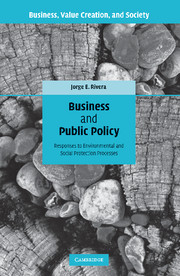Book contents
- Frontmatter
- Contents
- List of figures
- List of tables
- Foreword
- Acknowledgments
- Publication acknowledgments
- 1 Introduction
- 2 Business responses to the protective policy process in the US
- 3 Country context and the protective policy process–business response relationship
- 4 Firm-level characteristics and business responses to environmental/social protection demands
- 5 Is greener whiter? Resistance strategies by the US ski industry
- 6 Is greener whiter yet? Resistance or beyond-compliance by the US ski industry
- 7 Institutional pressures and proactive environmental protection: evidence from the Costa Rican hotel industry
- 8 Chief executive officers and proactive environmental protection: evidence from the Costa Rican hotel industry
- 9 Certified beyond-compliance and competitive advantage in developing countries
- 10 Conclusion
- References
- Index
5 - Is greener whiter? Resistance strategies by the US ski industry
Published online by Cambridge University Press: 03 May 2011
- Frontmatter
- Contents
- List of figures
- List of tables
- Foreword
- Acknowledgments
- Publication acknowledgments
- 1 Introduction
- 2 Business responses to the protective policy process in the US
- 3 Country context and the protective policy process–business response relationship
- 4 Firm-level characteristics and business responses to environmental/social protection demands
- 5 Is greener whiter? Resistance strategies by the US ski industry
- 6 Is greener whiter yet? Resistance or beyond-compliance by the US ski industry
- 7 Institutional pressures and proactive environmental protection: evidence from the Costa Rican hotel industry
- 8 Chief executive officers and proactive environmental protection: evidence from the Costa Rican hotel industry
- 9 Certified beyond-compliance and competitive advantage in developing countries
- 10 Conclusion
- References
- Index
Summary
In the late 1990s the US Forest Service (USFS) was developing revised land use plans for national forest lands, as required by the National Forest Management Act of 1976. Environmentalists' favored draft version of these land use plans proposed additional restrictions to recreational use, such as skiing and ski area development. The stringency of these restrictions was particularly high in western US national forest lands where major ski areas are located. For example, one of the proposed land use plans for Colorado's White River National Forest – home of renowned ski resorts such as Vail, Aspen, Breckenridge, Keystone, and Beaver Creek, among others – intended to forbid ski areas' expansion (Briggs, 2000). Not surprisingly, the adoption of more restrictive new land use plans was resisted not only by the ski industry but also by real-estate developing companies, recreation user groups, and local politicians, among others. This chapter examines in detail one of the resistance strategies adopted by the US ski industry: the creation and implementation of a voluntary environmental initiative named the Sustainable Slopes Program.
Since the early 1990s, more than 200 voluntary environmental programs have been created in the US with the stated intent of promoting proactive corporate environmental protection (Carmin et al., 2003). In the 1990s, the use of these programs as alternatives to command-and-control regulations became a core element of the federal government's environmental policy agenda (Dietz and Stern, 2002).
- Type
- Chapter
- Information
- Business and Public PolicyResponses to Environmental and Social Protection Processes, pp. 86 - 110Publisher: Cambridge University PressPrint publication year: 2010

